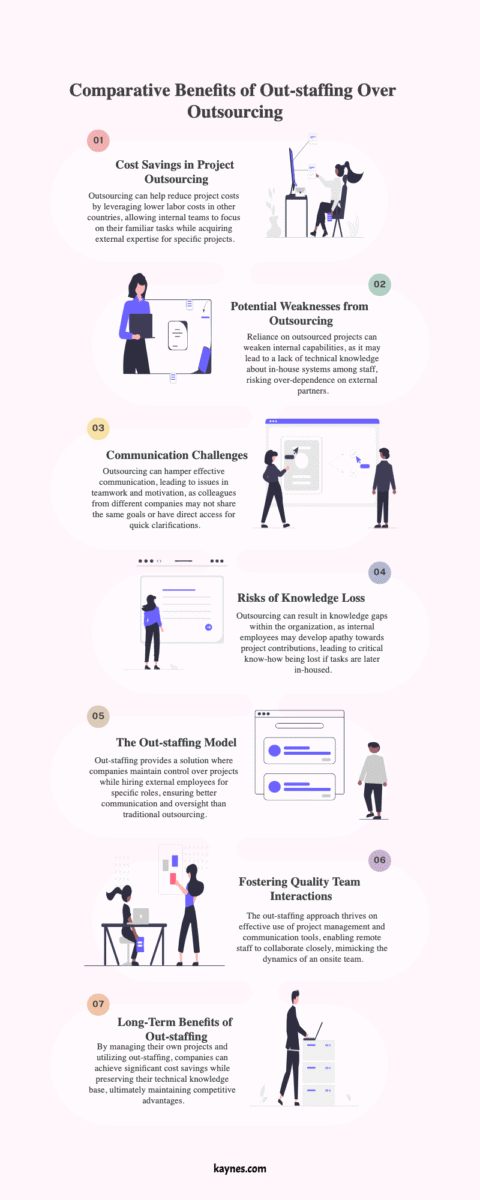
The advantage of moving from Outsourcing to Out-staffing
Outsourcing is an extensively adopted business practice.
Thank you for reading this post, don't forget to subscribe!However, the model has its inherent drawbacks – it often leads to lack of control, inconsistent quality, and impersonal relationships.
The solution? Outstaffing. Over the past decade, I’ve guided multiple businesses in this transition, resulting in greater efficiency, quality control, and workforce loyalty.
Outsourcing projects can lead to lower costs
Outsourcing which allows you to take advantage of lower cost labour pools in other countries, is certainly beneficial in these times of high competition for skilled labour.
For those who control project budgets, outsourcing a project is often very successful at significantly reducing costs especially in the short run. Outsourcing a project can allow your core team to focus on daily tasks they are already familiar with, while bringing in outside skills and knowledge you don’t currently have in-house to tackle a specific problem or project.

Outsourcing projects can also develop weaknesses in your own company
However, outsourcing can also produce some organisational weaknesses in your own company due to lack of technical and process knowledge developed about the systems you have built. Even if you have enough managerial oversight on an outsourced project to start with, over reliance and other focuses can cause your own staff to over time lose the ability to fix and maintain your own systems. At this point you must ask yourself “how much do you rely on another company? and how much leverage do they have over you?”.
When outsourcing at a project level, you should always be aware you are asking people who work for another company and do not (nor can be expected to) know about your business or industry as well as you do, to perform an important task. It is very easy to take a complete project such as an app or a website and give a long list of requirements (often broken into phases) and simply put them out to tender.
This is a great way to get the lowest price but how much do you really know about the other company’s capability to deliver a high-quality product that provides value over time? If the project is fundamental to your business success, it’s likely this will be a long-term relationship as most products or online systems have iterations and new versions.
A project that lacks communication and a shared goal can easily fail
Even if you successfully navigate the minefield and hire an outstanding outsourcing agency, issues often arise simply due to corporate psychology and apathy or just bad leadership failing to communicate priorities and motivate the team members to produce a high quality of work. The problem is things such as communication, teamwork and motivation which we try to produce in our on-site teams is not necessarily easily replicated down to the members of a team working in another company in a remote location.
Whereas within your own company for example a database developer could simply walk over and ask someone in the accounts department a question about what information they need to record for a particular transaction. When the person designing your database works for an outside company it’s likely you will lack the ability to have this kind of direct communication.
It’s also likely that an information bottleneck will form around those people who communicate directly with the external company in both your own company and that of the Outsourcer. These people at the interface can set the work priorities of people working on your project usually with little oversight. This can often lead to requirements from people or departments well connected to the bottlenecks can be given high priority, while other important requirements ignored or deprioritised.
Only those you trust should have your secret formula
Outsourcing projects to others can lead to an apathy from internal employees as to what skills, knowledge and processes are being developed in the project after all to them its someone else’s responsibility. And if suddenly you are required to in-house these tasks, that core knowledge and know how required to train a new team can be found lacking or completely missing! Even worse those secrets and processes of how you do business could also be transferred to a competitor or sold to the highest bidder. For these reasons you should consider your potential business partners very carefully when moving core work to a third party.
Out-staffing the third way…
Instead of outsourcing a whole project and inviting the problems we discussed above many companies have turned to a third way, which is running their own project in-
house while heavily out staffing many of the roles within that project. Typically, out-staffing is when your company fills roles within your team with employees working for a third company often working in a wage environment. This third company will allow its employees to work full time or part time for your company but also allowing you to retain full management over the project and staff.
This configuration arguably allows you to maintain close communication and visibility over projects while still bringing in new skills and capacity to your company at much lower cost than hiring. Picking specific jobs or roles within your project to keep in house such as lead developer, project manager or business analyst call allow you to retain and build system and process knowledge in your organisation while still outsourcing the bulk of the project work.
Working globally while keeping your team local
The out-staffing model works best when your onsite project staff work and communicate with those working from remote locations as closely as if they were in the same location. Today we can use team management (jira, trello, etc) and chat systems (google hangouts, skype, etc) to bring people together but it’s important to utilise these tools and actually have the regular meetings and communications required.
Often you may wish to instigate daily team meetings using video and voice with all the team members present inviting each one to give an update on what they are working on and any problems they face. These daily meetings can recreate the teamwork and sense of purpose that can be lost to remote workers working in fully outsourced projects. If there are team communications or meetings to discuss progress you should also include the whole team where possible instilling a collective responsibility within the team in-house and out-staffed members towards project success.
Wrapping Up
Out-staffing rather than outsourcing often leads to better results while still providing the cost reduction of using skilled labour from lower cost regions. Because out-staffing requires you to manage your own project you will need to learn how to use modern online team management and communications software to set priorities and motivate your team. But the upside of doing this is building and maintaining the technical and competitive advantage of your company. Allowing allowing you to fix and extend your own systems or product later without the risk and increased costs of being fully reliant on a third party.



